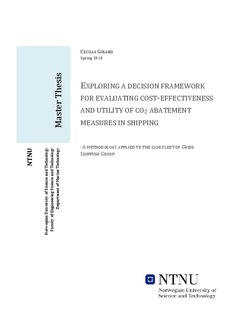| dc.description.abstract | Selecting greenhouse gas abatement measures for a specific fleet of ships is not an easy task and many factors are to be considered by ship operators. Current methodologies for assessing measures are based on cost-effectiveness evaluations. The main aim of this paper is to explore new ways to evaluate and select greenhouse gas abatement measures in shipping.
To address this, a case study regarding the open hatch bulk fleet of Grieg Shipping Group is presented in order to illustrate the decision problem. In this case, 25 abatement measures were evaluated for cost effectiveness and reduction effect using current methodology in combination with a qualitative ‘utility’ assessment of the measures.
Existing marginal abatement cost methodology was used to evaluate the cost-effectiveness of the chosen abatement measures. It was found that 37% of the current greenhouse gas emissions of
Grieg ships were abatable in a cost efficient way, using multiplicative aggregation. The savings potential was estimated to reach an annual amount of 1,5 million $ per year per ship.
The cost–effectiveness assessments was added to a qualitative ‘utility’ assessment using a methodology called Multi Criteria Decision Analysis. For each measure, this decision analysis included qualitative utility criteria such as safety considerations, technical maturity and complexity. Employees of Grieg Shipping Group were used both to score the performance of each alternative and to attribute weights of preference to the different criteria.
The results of the analysis yielded a cost-effectiveness ranking and a utility ranking. These two rankings were then aggregated in a Marginal Abatement Utility and Cost chart (MAUCC) where all three parameters; cost-effectiveness, utility score and reduction effect are presented at the same time(Figure 37). This chart can be seen as the primary outcome from the adopted decision framework, and summarizes a lot of information without overly simplifying. Its results as well as its use are discussed in chapters 5 and 6.
In this case study, some measures were found to have high ratings for both utility and costeffectiveness (“1-Voyage execution”, “9-Propeller condition”, “4-Engine monitoring”, “5-Reduction of aux. power” and “7-Trim/draft optimization”), while the more emerging abatement measures represented a higher reduction effect, but also lower cost – and utility scores (See “21-Kite” and “22-Fixed sails” or ”12-air cavity lubrication”). It is suggested that increased research on emerging abatement measures could increase their qualitative “utility scores”. Using the MAUCC chart it is shown that these new and exciting alternatives do not all need large qualitative improvements before they become viable alternatives for emission reduction.
A discussion on the obstacles to implementation of seemingly cost effective abatement measures is also conducted, and it is shown that the main factors identified by Grieg employees were circumstances related to the organization and uncertainty about pricing and benefit of abatement measures.
Discussion on the main findings as well as suggestions for further study is conducted in chapters 5, 6 and 7. | nb_NO |
